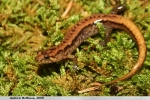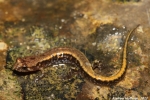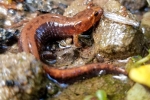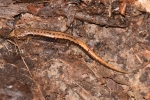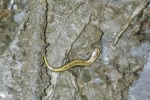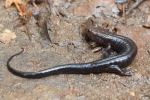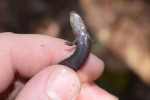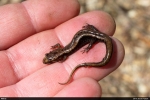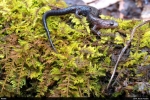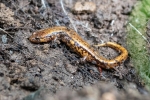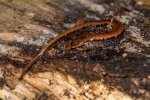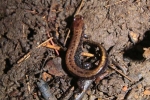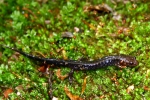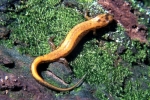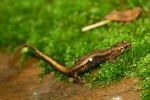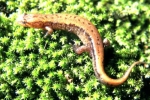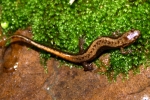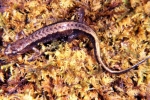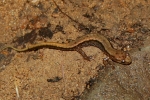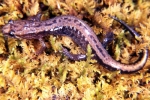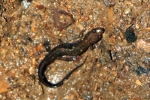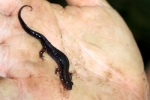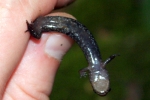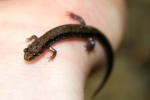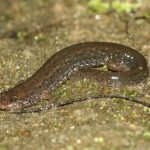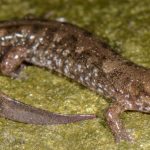Allegheny Mountain Dusky Salamander
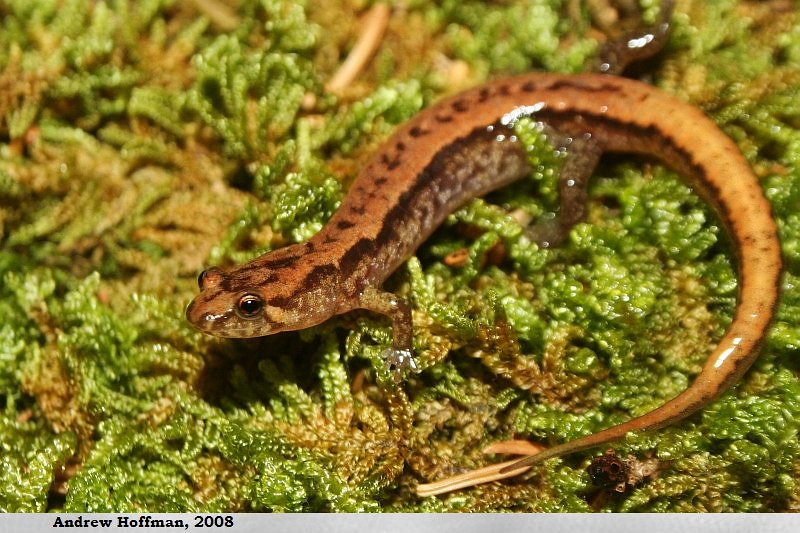
Scientific Name: Desmognathus ochrophaeus
Size: 2.75-4.25 inches (7-10 cm) in length
Status: Abundant
Habitat:
Moist deciduous or mixed hardwood-coniferous forest, small streams, springs and hillside seeps.
Description:
Small species. More terrestrial than the other Desmognatus salamanders. The upper body has a broad, straight-edged vertebral stripe that varies in color from yellow, red, orange to shades of brown and is bordered on each side by dark brown to black stripe that becomes lighter and mottled towards the belly. A medial row of dark chevron-shaped markings occur within the middle of the stripe, but they may be absent. The stripe extends from the back of the head though the body and onto the tail. The underside is light grey to greyish-black and immaculate or may be lightly mottled that becomes darkens with age. Older individuals are often melanistic or uniform dark brown to black.
Desmognathus genus are easily identified by the light line that extends from the eye to the angle of the jaw.
- The dorsal has a broad, straight-edged vertebral stripe that varies in color from yellow, red, orange to shades of brown and is bordered on each side by dark brown to black stripe that becomes lighter and mottled towards the ventral. A medial row of dark chevron-shaped markings occur within the middle of the stripe, but they may be absent. The stripe extends from the back of the head though the body and onto the tail.
- The ventral is light grey to greyish-black and immaculate or may be lightly mottled. The ventral darkens with age.
- Duskys are easily identified by the light line that extends from the eye to the angel of the jaw.
- Older individuals are often melanistic or uniform dark brown to black.
- Small species. More terrestrial than the other duskys.
- The tail is slightly longer than the body.
- The toe tips lack cornifications.
- 14 costal grooves.
- Similar to adults.
- The dorsal has a straight dorsolateral striped and lack alternating spot or they are restricted to the posterior portion of the body.
- The body is rounded.
- Limbs are well-developed.
- The tail is weakly keeled and 2/3s are laterally compressed.
- The head is large and distinct from the neck.
- The gills are short and slender.


no images were found
References:
- Hulse, C. and McCoy C. J. and Ellen Censky ,1998. Amphibians and Reptiles of Pennsylvania and the Northeast. 192-196pp.
- Petranka, James W. ,1998. Salamanders of the United States and Canada. 192-196pp.
- Jason Poston
- Tom Diez
- Kyle Fawcett
- Andrew Hoffman
Heads up!
Please contribute your observation of this and other herps to the Pennsylvania Amphibian and Reptile Survey. Your help is needed.
